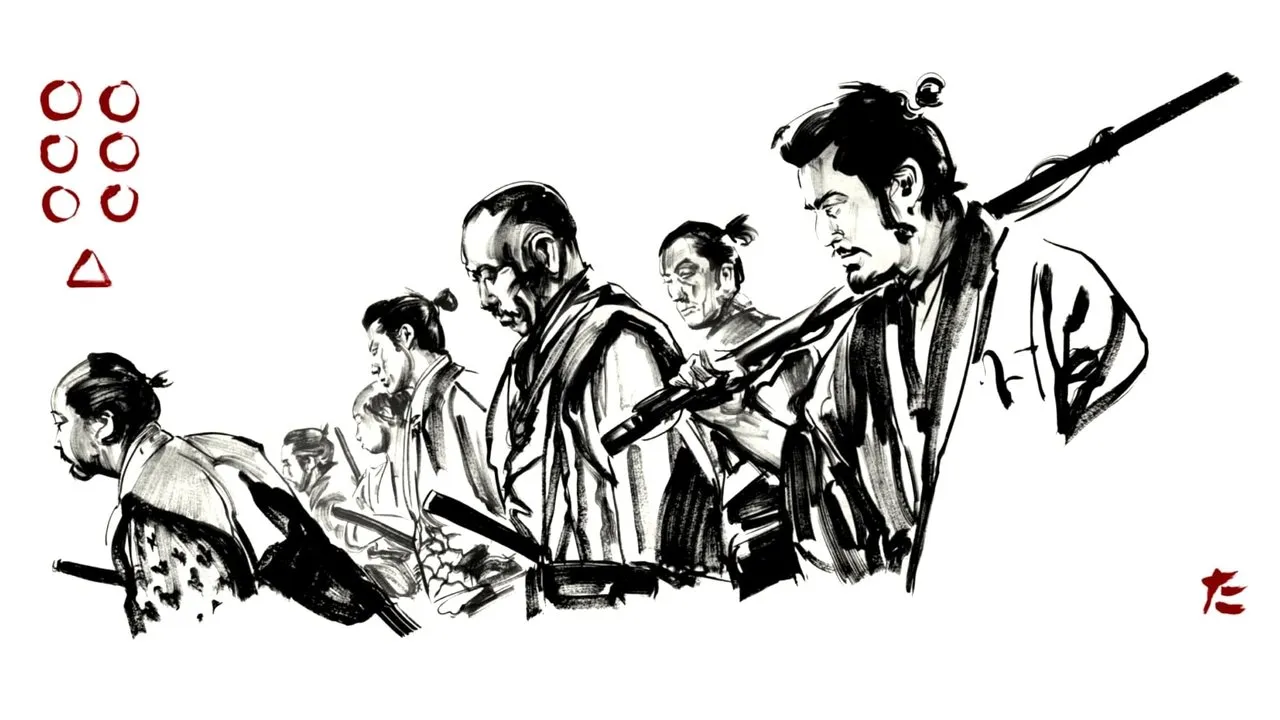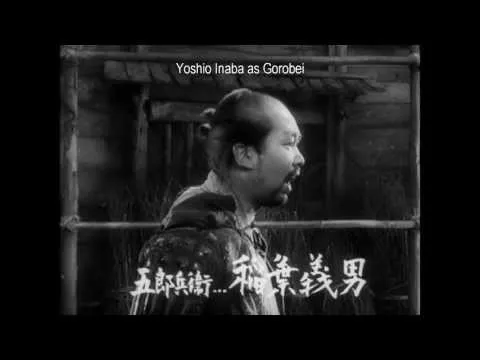
Work of art can have its quality measured by other works of art it inspired through time. The world of seventh art has plenty of such examples, and the best known are those which had inspired numerous remakes through decades. Among those remade movies the best are those that contain images, stories and characters deeply ingrained in the collective unconsciousness of their viewers, regardless of their cultural background. Probably the best known of such films is Seven Samurai, 1954 film by famous Japanese director Akira Kurosawa. This is equally famous for being the best example of "jidai-geki" (samurai picture) genre – Japanese equivalent of western – and for being inspiration for numerous other authors which had used its basic concept for movies set in different time periods, different locations and belonging to different genres.
The plot of this movie, loosely based on ancient Japanese legend, is set in late 16th Century Japan. The country is in the middle of civil war, the government authority has collapsed and the countryside is left to the roaming hordes of bandits. One of such gangs made a habit out of plundering a mountain village after each harvest and leaving barely enough food for peasants to survive. This time the village had been hit by especially hard times, and after one of the peasants accidentally overhears bandits discussing plans for their next visit, village council is ready to listen to young Rikichi (played by Yoshio Tsuchiya) who wants to fight bandits. But the villagers also know that they lack combat skills necessary to match dozens of well- armed thugs. Village elder Gisaku (played by Kokoden Kodo) advises them to go to town and hire services of ronins, masterless samurais, whose martial expertise would defend the village. When the group of peasants come to town, they see plenty of ronins, many of them penniless, but almost none would humiliate himself by offering his services to common peasants for three meals of rice per day. Their search is fruitless until they meet Kambei Shimada (played by Takashi Shimura), old, experienced but kind-hearted samurai who agrees to help them. He and his apprentice/disciple Katsushiro (played by Isao Kimura) gather four other ronins and six of them head for the mountains, followed by vagabond and samurai wannabe Kikujiro (played by Toshiro Mifune). The small army arrives in the village, greeted by scepticism, fear and distrust from the peasants, but they nevertheless begin preparations for defence.
When Kurosawa died, many obituaries called him the God of Cinema, and it was hardly an exaggeration. Anyone who watches Seven Samurai would understand why. Fans of Peckinpah, Lucas, Spielberg, Millius, Cameron and almost any respected modern-day action director would see many familiar scenes and motives in this film, made almost a half century ago. The influence Kurosawa had on future filmmakers is immeasurable, yet his films still look fresh, original and very modern. Seven Samurai, despite its black-and-white photography and despite its huge length (203 minutes in original cut), can be put in the same category with action classics like Die Hard and Aliens. This also explains why Kurosawa's work sticks out as the only black and white classic among entries in many personal Top 10 or Top 100 movie lists.
This movie is so successful because of its flawless direction and very balanced combination of powerful human drama and exciting action. Unlike most of the action directors today, Kurosawa knew that the audience wouldn't be satisfied just with the elaborate action scenes; audience needs characters to identify with it. Script by Kurosawa, Shinobu Hashimoto and Hideo Oguni is based on the very simple plot, but this plot is used as base for the whole series of interesting subplots and character studies. Never allowing the film to become stale and boring, Kurosawa slowly but methodically unfolds the plot and develops his characters, less through dialogue and more through the simple but revealing gestures. For that Kurosawa had to rely on very talented actors and he was very lucky to have more than adequate crew for the job. The top of the list is Takashi Shimura, descendant of real life samurai, who gives quiet yet powerful performance as the leader of small army; every community in the world would probably appreciate having someone like him in times of need. Seiji Myaguchi is also remarkable in the role of ascetic yet deadly samurai Kyuzo, same as Isao Kimura as young Katsushiro, forced to learn some ugly lessons in life. Yoshio Tsuchiya is great as Rikichi, hotheaded peasant who is deeply traumatised by personal tragedy. The best known of them all is, of course, Toshiro Mifune, Kurosawa's favourite actor, who gives more than memorable portrayal of Kikujiro, lowlife who begins the film as comic relief and gradually evolves into real hero.
Kurosawa, having such great characters and such great actors on his disposal, established rather interesting interactions, but that didn't interest him only on individual level. Like very few action movies before and after, Seven Samurai actually deals with broader social issues. In the context of 16th Century Japan this issue was class conflict between peasants and feudal class, embodied in samurai. Kurosawa always keeps viewers aware of such conflict - peasants and samurai can live and work together, but this relationship is temporary and based only on short-term interest. Both classes are inimical towards each other - samurai look on the peasants like inferior beings, while peasants mistrust samurai. Character of Kikujiro explicitly explains this class conflict through memorable and powerful monologue. This social dimension of Seven Samurai, although it could be replanted from feudal Japan through different times and places, wasn't very convincingly used in this film's remakes (which is especially the case with American 1960 version).
Despite having a story with universal appeal, Kurosawa has put a lot of effort for historical accuracy in Seven Samurai. Clothes, houses and folklore of 16th Century rural Japan are painstakingly recreated, as well as the weapons and armour of the samurai. But the best thing about this historical reconstruction is Kurosawa's great care about combat scene. Fighting in Seven Samurai doesn't just look exciting, it is very realistic and, unlike most of the war and action movies, it actually makes sense. Individuals play very limited role, just like in any other war; unlike Rambo movies with superhuman heroes that eliminate hundreds of well-armed opponents, superior numbers, tactics, training and firepower does matter. Samurai might be superior in one-on-hand and hand-to-hand combat (such fights are very short and decided in matter of seconds), but even they are powerless against bandits' firearms. Victory comes out of collective action, with few making painful sacrifices for the benefits of the many. Same as in any military textbook from Sun Zi to this day, good planning in Seven Samurai plays more important role in acquiring victory than actual fighting itself. It is marvel to watch scenes in which Kambei, like any other good general, surveys and sketches the future battlefield and makes mental notes about best ways to defeat the enemy. This dimension of Seven Samurai is also missed from all latter remakes.
Kurosawa was very pedantic about scenes depicting the war, but Seven Samurai could hardly be seen as militaristic propaganda. Realism in battle scenes also means that the death in war happens without any rules; characters often die in agony or covered with mud or similar prosaic circumstances. War equally brings out the best and worst from people, the latter being symbolised in brutal acts of violence and succumbing to animalistic desires, even among the most innocent and idealistic characters like Katsushiro. Wars, even when they are justified and when they end with victory, are hardly something that should be celebrated. Kurosawa underlines this message with bittersweet final scene.
With the sole exception Fumio Hayasaka's musical score that sounds a little bit old- fashioned for today's standards, Seven Samurai withstood the test of time. But this is just one of many reasons why this film earned its rightful place as the timeless gem of world cinema.
RATING: 9/10 (++++)
(Note: The text in its original form was posted in Usenet newsgroup rec.arts.movies.reviews on June 15th 2000)
==
Blog in Croatian https://draxblog.com
Blog in English https://draxreview.wordpress.com/
Cent profile https://beta.cent.co/@drax
Minds profile https://www.minds.com/drax_rp_nc
Brave browser: https://brave.com/dra011
BTC donations: 1EWxiMiP6iiG9rger3NuUSd6HByaxQWafG
ETH donations: 0xB305F144323b99e6f8b1d66f5D7DE78B498C32A7
Movie URL: themoviedb.org/movie/346?language=en-US
Critic: AAA
